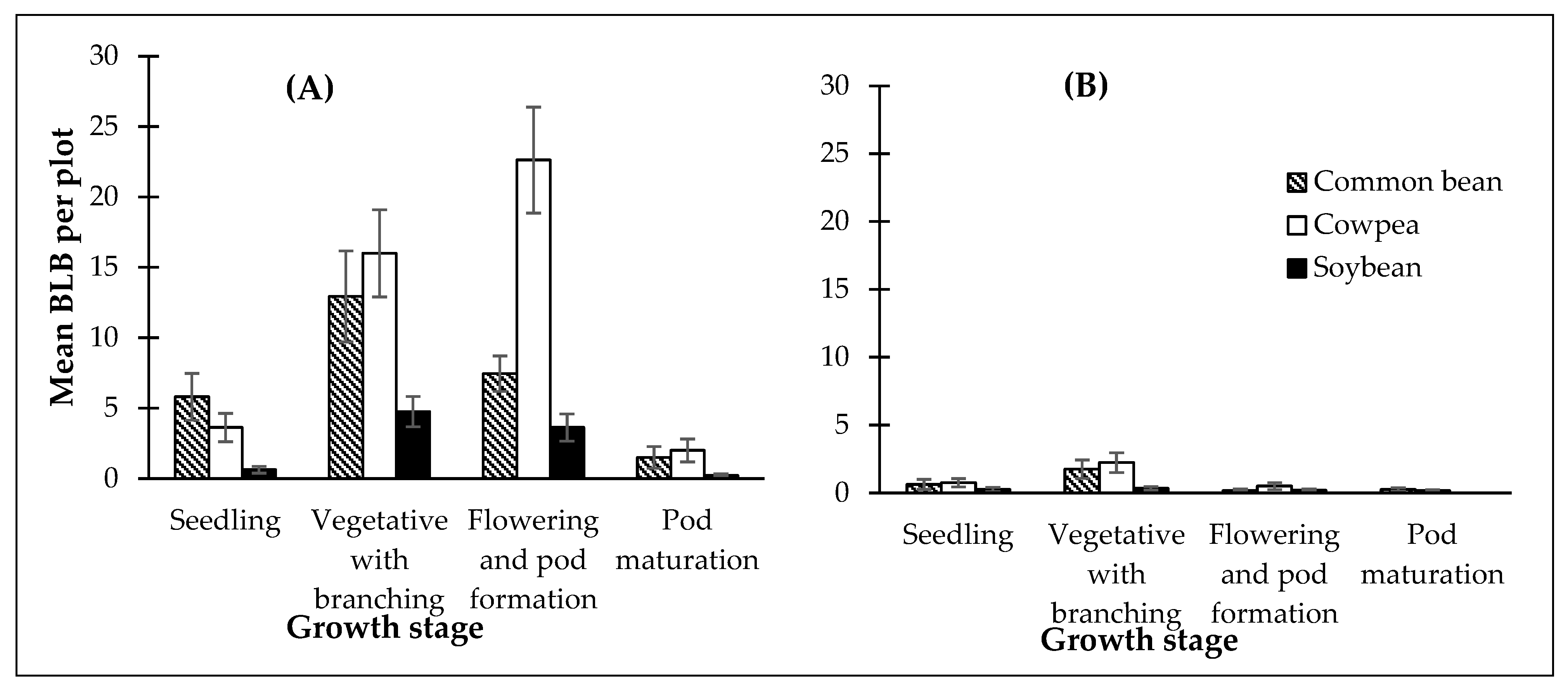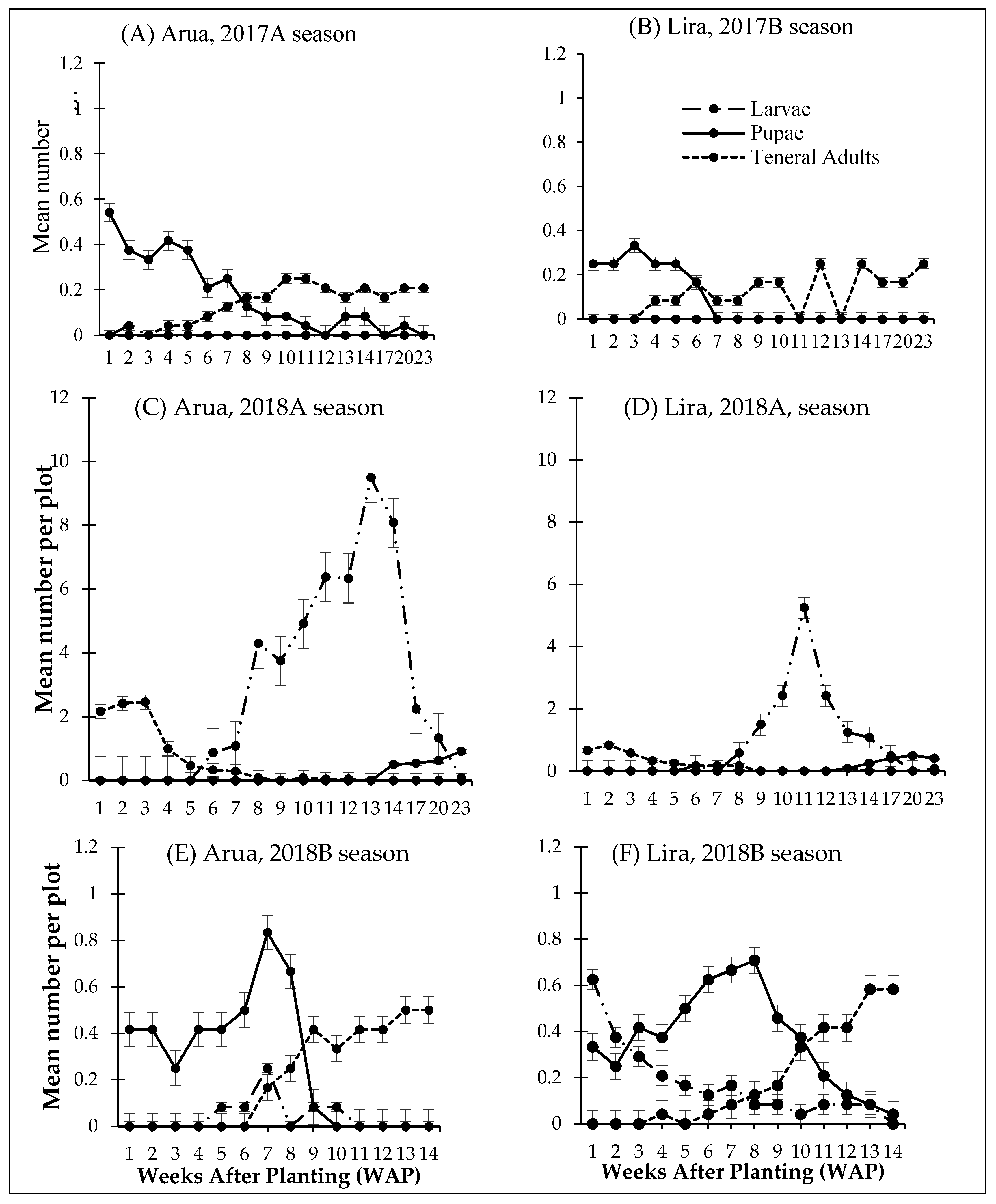Host and Seasonal Effects on the Abundance of Bean Leaf Beetles (Ootheca spp.) (Coleoptera: Chrysomelidae) in Northern Uganda
Abstract
Simple Summary
Abstract
1. Introduction
2. Materials and Methods
2.1. Study Areas
2.2. Crops Used in the Study
2.3. Study Design
2.4. Assessment of the Above-Ground Abundance and Leaf Damage Caused by Ootheca Species
2.5. Assessment of Below-Ground Life Stages of Ootheca spp.
2.6. Data Analysis
3. Results
3.1. Influence of Season and Host Plants on the Abundance, Distribution, and Leaf Damage by Ootheca Species
3.2. Influence of Host Plant Phenological Stages on the Abundance of Ootheca Species
3.3. Seasonal Abundance of BLBs, Leaf Damage, and Incidence Fir Common Bean, Cowpea and Soybean
3.4. Influence of Host Plants on the Abundance and Distribution of Life Stages of Ootheca spp. (BLB) below Ground
3.5. Seasonal Variation in Abundance of Below-Ground Immature Life Stages of BLB across Arua and Lira Districts
4. Discussion
5. Conclusions
Supplementary Materials
Author Contributions
Funding
Institutional Review Board Statement
Informed Consent Statement
Data Availability Statement
Conflicts of Interest
References
- Grobbelaar, E. On the identity of Ootheca bennigseni Weise, O. mutabilis (Schönherr) and O. meridiana sp. n. (Chrysomelidae: Galerucinae), bean and cowpea pests in the Afrotropical Region. Afr. Èntomol. 2008, 16, 7–22. [Google Scholar] [CrossRef]
- Kortenhaus, S.; Wagner, T. Revision of Ootheca Chevrolat, 1837 from tropical Africa—redescriptions, descriptions of new species and identification key (Coleoptera: Chrysomelidae, Galerucinae). Zootaxa 2010, 2659, 1–52. [Google Scholar] [CrossRef]
- Karel, A.K.; Rweyemamu, C.L. Yield Losses in Field Beans Following Foliar Damage by Ootheca bennigseni (Coleoptera: Chrysomelidae). J. Econ. Èntomol. 1984, 77, 762–765. [Google Scholar] [CrossRef]
- Karel, A.K.; Autrique, A. Insects and Other Pests in Africa. In Bean Production Problems in the Tropics; Schwartz, H.F., Pastor-Corrale, M.A., Eds.; Centro International de Agricultura Tropical: Cali, Columbia, 1989; pp. 455–504. ISBN 9589183042. [Google Scholar]
- Halerimana, C. Distribution of Bean Leaf Beetles and Associated Yield Losses in Uganda, College of Agricultural and Environmental Sciences; Makerere University: Kamapala, Uganda, 2019. [Google Scholar]
- Ossey, C.L.; Aboua, L.R.N.; Tano, D.K.C.; Obodji, A. Seasonal Variation of the Population of Ootheca Mutabilis Sahlberg (Coleoptera: Chrysomelidae) on the Cowpea (Vigna Unguiculata L.) in Adzopé, South of Côte d’Ivoire. Sch. Acad. J. Biosci. 2017, 5, 459–464. [Google Scholar]
- Halerimana, C.; Kyamanywa, S.; Olaboro, S.; Paparu, P.; Nkalubo, S.T.; Colvin, J.; Cheke, R.A.; Wagner, T.; Seal, S.E.; Kriticos, D.J.; et al. Distribution and Relative Abundance of Bean Leaf Beetles (Ootheca Pp.) (Insecta: Coleoptera: Chrysomelidae) in Uganda. Insects 2021, 12, 1048. [Google Scholar] [CrossRef] [PubMed]
- Ampofo, J.K.O.; Hallenwenger, U.; Massomo, S.M.; Ulicky, E. Participatory IPM Development and Extension: The Case of Bean Foliage Beetles in Hai, Northern Tanzania. In Proceedings of the PABRA Millennium Workshop, Arusha, Tanzania, 28 May 2005; Pan-Africa Bean Research Alliance (PABRA): Arusha, Tanzania, 2005; pp. 87–95. [Google Scholar]
- Kyamanywa, S.; Mukiibi, J.; Otim, M. Use of Trap Crops in the Management of Leaf Beetles on Common Beans in Apach District of Uganda. In Proceedings of the African Crop Science Conference Proceedings; African Crop Science Society, Lagos, Nigeria, 22–26 October 2001; Volume 5, pp. 167–170. [Google Scholar]
- Mugonza, J. Farmers’ Awareness of Bean Leaf Beetles (Ootheca spp.) and the Virulence of Aspergillus Flavus and Metarhizium Anisopliae against These Pests in Uganda; Makerere University: Kamapala, Uganda, 2021. [Google Scholar]
- Peacock, A.D. Entomological pests and problems of Southern Nigeria. Bull. Èntomol. Res. 1913, 4, 191–220. [Google Scholar] [CrossRef]
- Adipala, E.; A Omongo, C.; Sabiti, A.; E Obuo, J.; Edema, R.; Bua, B.; Ogenga-Latigo, M.W. Pests and diseases of cowpea in Uganda: Experiences from a diagnostic survey. Afr. Crop Sci. J. 1999, 7, 465–478. [Google Scholar] [CrossRef]
- Abudulai, M.; Salifu, A.B.; Opare-Atakora, D.; Haruna, M.; Denwar, N.N.; Baba, I.I. Yield loss at the different growth stages in soybean due to insect pests in Ghana. Arch. Phytopathol. Plant Prot. 2012, 45, 1796–1809. [Google Scholar] [CrossRef]
- Ampofo, J.K.O.; Mziray, H.; Minja, E. Make Available More Options for Managing Soil Productivity and Bean Pests: Biology and Ecology of Bean Foliage Beetle (Ootheca Spp.) in Support of IPM 2001, 256–257. Available online: http://ciat-library.ciat.cgiar.org/articulos_ciat/bean_entomology.pdf (accessed on 23 May 2017).
- UBOS. Uganda Bureau Of Statistics (UBOS) Uganda Census of Agriculture: Crop Area and Production Report 2008/2009; UBOS: Kampala, Uganda, 2010; Volume 4. [Google Scholar]
- Flinte, V.; Hentz, E.; Morgado, B.M.; Lima, A.C.D.M.; Khattar, G.; Monteiro, R.F.; Macedo, M.V. Biology and phenology of three leaf beetle species (Chrysomelidae) in a montane forest in southeast Brazil*. ZooKeys 2015, 547, 119–132. [Google Scholar] [CrossRef] [PubMed]
- Ochieng, R.S. Studies on the Bionomics of Cowpea Leaf Beetle, Ootheca Mutabilis. In Pests of grain legumes: Ecology and Control; Singh, S.R., Van Emden, H.F., Taylor, T.A., Eds.; Academic Press: London, UK, 1978; pp. 187–191. [Google Scholar]
- Paul, U.; Ampofo, J.; Hilbeck, A.; Edwards, P. Evaluation of organic control methods of the bean beetle Ootheca bennigseni in East Africa. N. Z. Plant Prot. 2007, 60, 189–198. [Google Scholar] [CrossRef]
- Wortmann, C.S.; Eledu, C.A. Uganda’s Agro-Ecological Zone: A Guide For planners and Policy Makers; Centre for International Tropical Agriculture (CIAT): Kampala, Uganda, 1999. [Google Scholar]
- Schwartz, H.F.; Langham, M.A.C. Growth Stage of Common Bean. USDB Legum. ipmPIPE Diagnostic Pocket Ser. 2015.
- Blubaugh, C.K.; Caceres, V.A.; Kaplan, I.; Larson, J.; Sadof, C.S.; Richmond, D.S. Ground Beetle (Coleoptera: Carabidae) Phenology, Diversity, and Response to Weed Cover in a Turfgrass Ecosystem. Environ. Entomol. 2011, 40, 1093–1101. [Google Scholar] [CrossRef] [PubMed]
- Khaliq, A.; Javed, M.; Sohail, M.; Sagheer, M. Environmental Effects on Insects and Their Population Dynamics. J. Entomol. Zool. Stud. 2014, 2, 1–7. [Google Scholar]
- Miller, J.R.; Strickler, K.L. Finding and Accepting Host Plants. In Chemical Ecology of Insects; Bell, J.W., Carde, R.T., Eds.; Chapman and Hall Ltd.: Boca Raton, FL, USA, 1984; pp. 127–157. [Google Scholar]
- Ampofo, J.K.O.; Massomo, S.M. Host Effects on Bean Foliage Beetle (Coleóptera: Chrysomelidae) Emergence Pattern in Northern Tanzania; SADC Rgional Program on Beans: Potchefstroom, South Africa, 1998; pp. 109–110. [Google Scholar]
- Berzitis, E.A.; Minigan, J.N.; Hallett, R.H.; Newman, J.A. Climate and host plant availability impact the future distribution of the bean leaf beetle (Cerotoma trifurcata). Glob. Chang. Biol. 2014, 20, 2778–2792. [Google Scholar] [CrossRef] [PubMed]
- Sharma, H.C. Climate Change Effects on Insects: Implications for Crop Protection and Food Security. J. Crop Improv. 2014, 28, 229–259. [Google Scholar] [CrossRef]
- Buruchara, R.; Mukankusi, C.; Ampofo, J.K.O. Bean Disease and Pest: Handbooks for Small-Scale Seed Producers, 4th ed.; Bruchara, R., Mukankusi, C., Ampofo, K., Eds.; Centro International de Agricultura Tropical (CIAT): Kampala, Uganda, 2010. [Google Scholar]



| Factor | Number of BLBs per Plot | Leaf Damage | Plants with BLB (%) |
|---|---|---|---|
| Season effects | |||
| 2017B | 0.16 ± 0.03 a | 1.33 ± 0.03 b | 1.5 ± 0.27 b |
| 2018A | 5.72 ± 0.58 b | 1.71 ± 0.04 c | 21.5 ± 1.71 c |
| 2018B | 0.02 ± 0.01 a | 1.11 ± 0.05 a | 0.1 ± 0.05 a |
| District (Location) effects | |||
| Arua | 3.39 ± 0.37 b | 1.57 ± 0.03 b | 13.0 ± 1.12 b |
| Lira | 0.19 ± 0.03 a | 1.15 ± 0.04 a | 1.2 ± 0.21 a |
| Host plant effects | |||
| Common bean | 1.66 ± 0.28 b | 1.56 ± 0.05 b | 7.5 ± 1.14 b |
| Cowpea | 3.45 ± 0.53 c | 1.63 ± 0.04 b | 11.5 ± 1.4 b |
| Soybean | 0.78 ± 0.15 a | 0.96 ± 0.03 a | 4.1 ± 0.76 a |
| BLB Life Stage A | Host Plant | Mean Number Recovered per Plot * | |
|---|---|---|---|
| Within 20 cm Diameter around Plant | Further than 20 cm from Plant | ||
| Larvae | Common bean | 0.69 ± 0.258 a | 1.25 ± 0.467 a |
| Cowpea | 3.17 ± 0.922 b | 5.55 ± 1.293 b | |
| Soybean | 0.28 ± 0.117 a | 0.22 ± 0.077 a | |
| Pupae | Common bean | 0.16 ± 0.052 a | 0.60 ± 0.080 b |
| Cowpea | 0.21 ± 0.070 a | 1.22 ± 0.153 c | |
| Soybean | 0.07 ± 0.029 a | 0.10 ± 0.037 a | |
| Below-ground adults | Common bean | 0.64 ± 0.282 a | 0.62 ± 0.138 b |
| Cowpea | 0.69 ± 0.250 a | 1.01 ± 0.163 b | |
| Soybean | 0.16 ± 0.073 a | 0.08 ± 0.032 a | |
| BLB Life Stage | Season | Mean Number per Plot (mean ± s.e.m) ¥ | |
|---|---|---|---|
| Arua | Lira | ||
| Larvae | 2017B | 0.002 ± 0.245 a | 0 |
| 2018A | 2.960 ± 0.249 b | 0.897 ± 0.096 b | |
| 2018B | 0.042 ± 0.382 a | 0.173 ± 0.075 a | |
| Pupae | 2017B | 0.18 ± 0.028 a | 0.09 ± 0.042 a |
| 2018A | 0.13 ± 0.028 a | 0.10 ± 0.042 a | |
| 2018B | 0.29 ± 0.043 b | 0.37 ± 0.033 b | |
| Below-ground adults | 2017B | 0.14 ± 0.058 a | 0.11 ± 0.036 a |
| 2018A | 0.57 ± 0.059 b | 0.19 ± 0.036 a | |
| 2018B | 0.21 ± 0.090 a | 0.20 ± 0.028 a | |
Publisher’s Note: MDPI stays neutral with regard to jurisdictional claims in published maps and institutional affiliations. |
© 2022 by the authors. Licensee MDPI, Basel, Switzerland. This article is an open access article distributed under the terms and conditions of the Creative Commons Attribution (CC BY) license (https://creativecommons.org/licenses/by/4.0/).
Share and Cite
Lutaakome, M.; Kyamanywa, S.; Paparu, P.; Olaboro, S.; Halerimana, C.; Nkalubo, S.T.; Otim, M.H. Host and Seasonal Effects on the Abundance of Bean Leaf Beetles (Ootheca spp.) (Coleoptera: Chrysomelidae) in Northern Uganda. Insects 2022, 13, 848. https://doi.org/10.3390/insects13090848
Lutaakome M, Kyamanywa S, Paparu P, Olaboro S, Halerimana C, Nkalubo ST, Otim MH. Host and Seasonal Effects on the Abundance of Bean Leaf Beetles (Ootheca spp.) (Coleoptera: Chrysomelidae) in Northern Uganda. Insects. 2022; 13(9):848. https://doi.org/10.3390/insects13090848
Chicago/Turabian StyleLutaakome, Moses, Samuel Kyamanywa, Pamela Paparu, Samuel Olaboro, Charles Halerimana, Stanley Tamusange Nkalubo, and Michael Hilary Otim. 2022. "Host and Seasonal Effects on the Abundance of Bean Leaf Beetles (Ootheca spp.) (Coleoptera: Chrysomelidae) in Northern Uganda" Insects 13, no. 9: 848. https://doi.org/10.3390/insects13090848
APA StyleLutaakome, M., Kyamanywa, S., Paparu, P., Olaboro, S., Halerimana, C., Nkalubo, S. T., & Otim, M. H. (2022). Host and Seasonal Effects on the Abundance of Bean Leaf Beetles (Ootheca spp.) (Coleoptera: Chrysomelidae) in Northern Uganda. Insects, 13(9), 848. https://doi.org/10.3390/insects13090848









